Famous Chinese Paintings – Discover Ancient Chinese Paintings
Traditional art history in many educational institutions tends to focus on Western-driven narratives and artists as the major art historical canon from which art students are expected to learn from. The art of painting in the West has produced many great masters from which to study and learn and whose technical approach and contribution to impactful art movements are still valuable. In this article, we will explore the art of the East and more specifically, Chinese painting, which will expand your notion of painting in the broader context of the world. Chinese painting remains one of the oldest surviving art forms from the ancient world since it is a unique style and approach to painting that inspires many to consider creative ways of viewing, making, and interpreting paintings.
An Introduction to Chinese Painting
Painting as an art form is one of the first visual expressions of man. The dominant subjects of art history are often derived from the Western historical point of view as the primary mode of learning and understanding art in the broader context. Here, we will turn your attention to the art of the East via Chinese painting.
Chinese painting is considered an ancient practice and tradition understood as guó huà.
This refers to the act of painting in the traditional Chinese manner and translates to “national painting”, thus highlighting the inherent traditional aspect of the act of painting. Towards the turn of the 20th century, the influences of Western art were already entrenched in the art world of the East and many adaptations of traditional Chinese painting and Western painting techniques emerged.

Traditional Chinese paintings are often executed using a brush, colored pigments, black ink, and materials such as paper and silk as the “canvas”. Note that oil paints are not used in Chinese paintings. Other materials that traditional Chinese painting is executed on include lacquerware, walls, album sheets, and folding screens. What distinguishes Chinese painting from the Western approach is not only the medium but the format and subject matter. Chinese paintings celebrated landscapes as subject matter as well as portraits, folklore, and animals.
Chinese landscape paintings are also executed on vertically-oriented materials as opposed to the Western approach of horizontal formats.
The two primary techniques used in Chinese painting include Gongbi, which translates to “meticulous” and is characterized by highly-detailed renderings of subject matter with fine, clear brushstrokes made with precision in mind. These paintings are often quite vivid and contain narrative or figural subjects that are made for high-profile clients. Artists who produced these paintings would be employed by the royal court or operate via independent workshops.

The other technique in traditional Chinese painting is shuǐ-mò, which is executed in ink and wash and referred to as “literati painting”. Literati painting was considered one of the four major art forms of the Chinese scholar-official class and was an art practiced by men who were regarded as “gentlemen”. This form of painting is also called the freehand style, xieyi.
The classical style of Chinese paintings was defined by artists who operated between the Five Dynasties period and the Northern Song era and included figures like Li Cheng, Guo Xi, Jing Hao, Dong Yuan, and Juran.
Famous Chinese Paintings
In the 5th century, an art historian named Xie He established the six principles of Chinese painting that shed insight into the underlying themes and spirit of early Chinese painting. These six principles were to be used to judge paintings as per ancient practices.
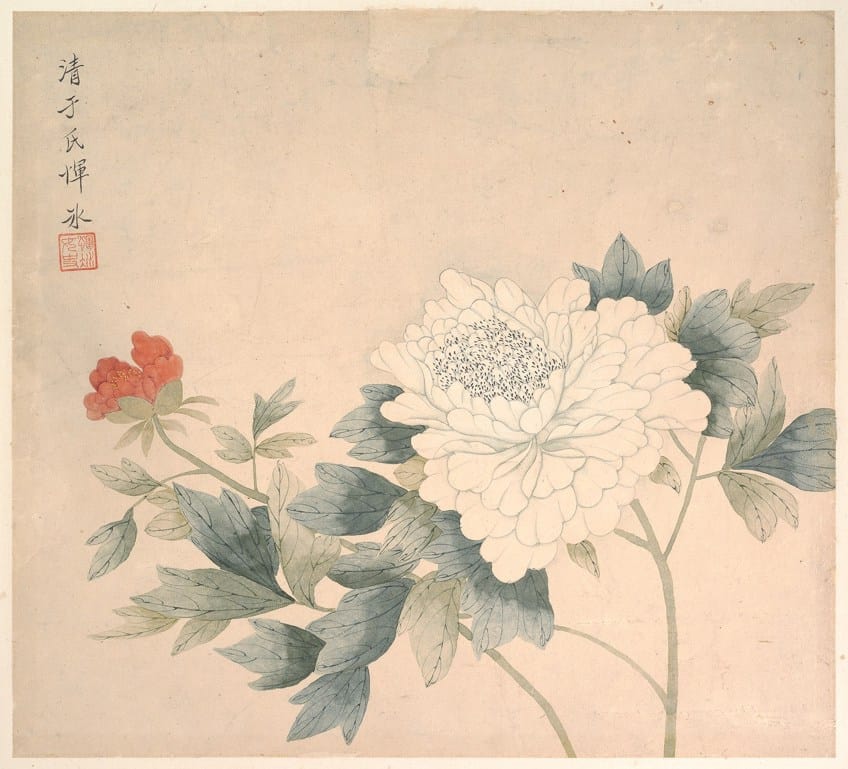
The principles include vitality (this relates to the flow of energy related to the artist, the work, and the theme of the artwork, the bone method (which refers to the manner of using the brush and encompassing the style of the brushwork and the artist’s unique personality through writing), the depiction of form or objects (this includes line and shape), the application of color (spanning value, layering, and tonal qualities), placement and arrangement (referring to the composition, depth, and space), and lastly the copying of objects from both real life and artworks of antiquity.
These six principles can perhaps be useful when viewing any artwork and provide us with valuable insight into the process of observation when deciphering the meaning of an artwork.
The six principles are a great holistic approach to understanding Chinese painting in a traditional sense, as well as extremely useful to know moving forward. Now, we will take a look at some of the most famous Asian paintings in the world!
Funeral Banner of Lady Dai (c. 160 BCE)
| Artist | Unknown |
| Date | c. 160 BCE |
| Period | Han Dynasty (206 – 220 BCE) |
| Medium | Silk |
| Dimensions (cm) | 205 x 92 x 47.7 |
| Where It Is Housed | Hunan Provincial Museum, Changsha, China |
This delicately painted funerary banner was discovered in the 1970s by archaeologists who uncovered the tomb of a wealthy woman known as Lady Dai. This famous Chinese silk painting is made up of four horizontal layers with progressing scenes of the underworld, the earthly realm, and the immortal world. The central image depicts Lady Dai with her family and attendants.
Below this scene, she is seen being presented with a funeral feast and sacrifices that are meant to guide her soul to the land of the immortals.
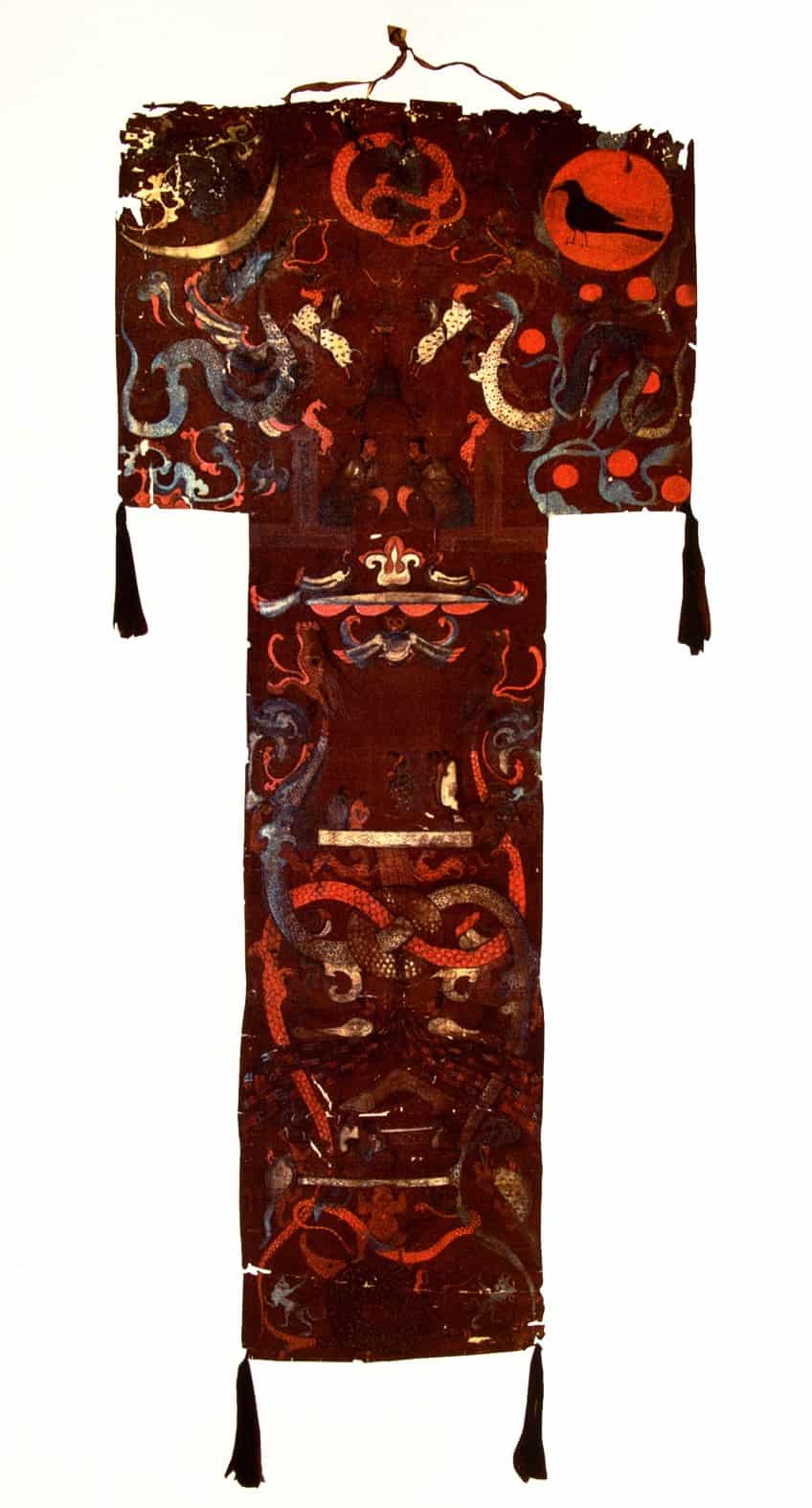
Giant intertwined serpents symbolize the underworld where Lady Dai’s corporeal soul remains as her spirit ascends to the immortal world above. This incredible and unique painting offers valuable insight into the beliefs of the culture at the time under the Han Dynasty (206 – 220 BCE) and serves as an important historical document.
Five Oxen (Tang Dynasty) by Han Huang
| Artist | Han Huang (723 – 787) |
| Period | Tang Dynasty (618 – 907) |
| Medium | Handscroll; ink and color on paper |
| Dimensions (cm) | 20.8 x 139.8 |
| Where It Is Housed | The Palace Museum, Beijing, China |
This oxen painting was created by Han Huang, a prime minister of the Tang Dynasty, which occurred between the years 618 and 907. The once-lost painting was only recovered in the 1950s by a collector in Hong Kong and is currently housed at the Palace Museum in Beijing, China. Five Oxen presents exactly what the title suggests and showcases the splendor of these hardy animals.
Huang demonstrates his flair for earthy tones and well-placed sharp brushstrokes combined with patches of color to create the weighty bodies of the oxen.
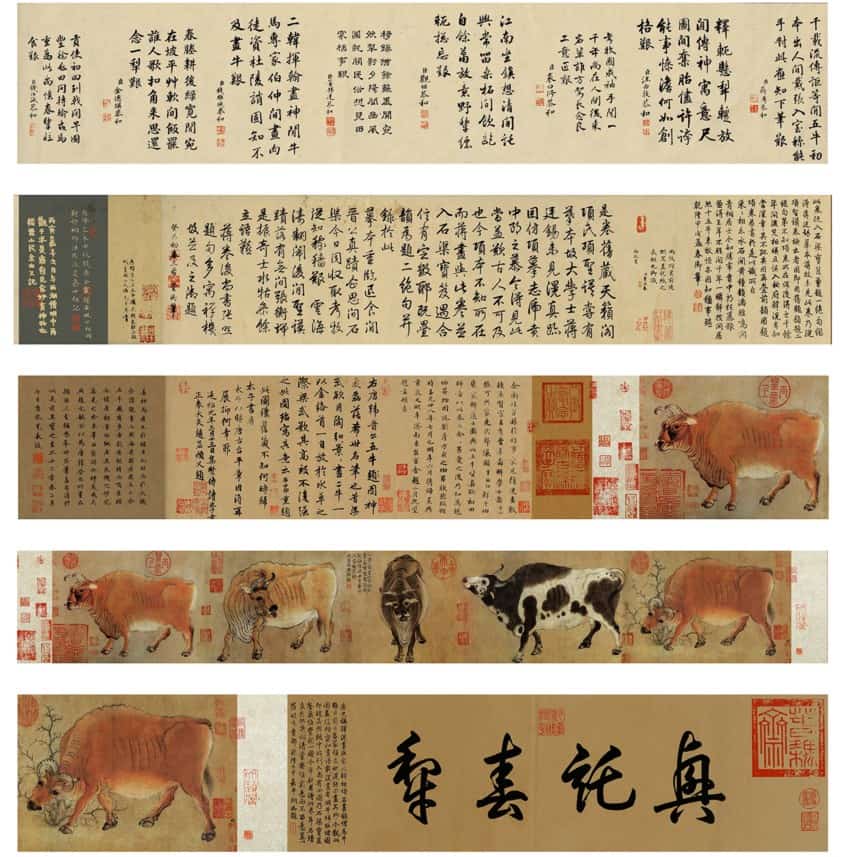
The oxen are presented in different postures to add character to the holistic nature of the animal’s movements. The artist also acknowledges the struggle of the animals in their function to perform laborious tasks for humans without complaining by presenting them as willing subjects.
This is one of the most famous Chinese paintings for the fact that it is a rare find under the genre of animal painting and most surviving ancient Chinese paintings often depict other imagery such as figures, flowers, or birds.
Court Ladies Adorning Their Hair with Flowers (8th – 9th Century CE) by Zhou Fang
| Artist | Zhou Fang (730 – 800 CE) |
| Date | Late 8th – Early 9th century CE |
| Period | Tang Dynasty (618 – 907) |
| Medium | Colors on silk |
| Dimensions (cm) | 45.5 x 175.5 |
| Where It Is Housed | Liaoning Provincial Museum; China Modern Contemporary Art Document, Beijing, China |
This stunning Chinese painting illustrates the different court women clothed in garments with striking red fabric, adorning themselves with flowers in their hair. Although the exact date of creation has not been established, this painting is on top of the list of classical Chinese paintings showing five noblewomen in the imperial courtyard. Their garments also reflect the changing seasons through the floral imagery of Spring flowers, as Spring moves into Summer.
The painting’s creator, Zhou Fang operated during the Tang dynasty in modern-day Xi’an. Fang was a man with a noble background, as reflected in works such as this one.

Fang drew inspiration from other artistic leaders like Lu Tanwei and Gu Kaizhi and was considered a prominent figure of the Tang dynasty following his contemporary, Wu Daozi. Fang was also recognized for his religious paintings of Buddha, which was established as a standard known as Zhou Jiaxiang. In Court Ladies Adorning Their Hair with Flowers, one can observe the use of depth through the size of the figures in the foreground and those receding in a dancing pattern.
According to customary Chinese painting methods, the most important figures would also be highlighted in the foreground and appear larger in stature than figures of less importance.
The woman dressed in red with the most lavish dress indicates that this was a woman of high noble rank. However, all the women wear the same type of makeup, which makes it difficult (and interesting) for historians to distinguish if this could be the same woman.
A Solitary Temple Amid Clearing Peaks (c. 960 – 1127) by Li Cheng
| Artist | Li Cheng (919 – 967 CE) |
| Period | Song Dynasty (960 – 1279) |
| Medium | Hanging scroll, ink, and color on silk |
| Dimensions (cm) | 1419 x 2838 |
| Where It Is Housed | The Nelson-Atkins Museum of Art, Kansas City, Missouri, USA |
Xiánxī or Li Cheng was one of the most famous Chinese artists who created some of the most iconic ancient Chinese paintings of all time. Li Cheng was a famous landscape painter who operated during the early Song Dynasty. Li Cheng’s lineage goes back to the Tang Dynasty Imperial family, Li, which fell out of power by the year 907 after the fall of the Tang Empire.
Li Cheng was incredibly dedicated to his artistic development and created his unique style of painting using diluted ink and landscapes with a misty effect.
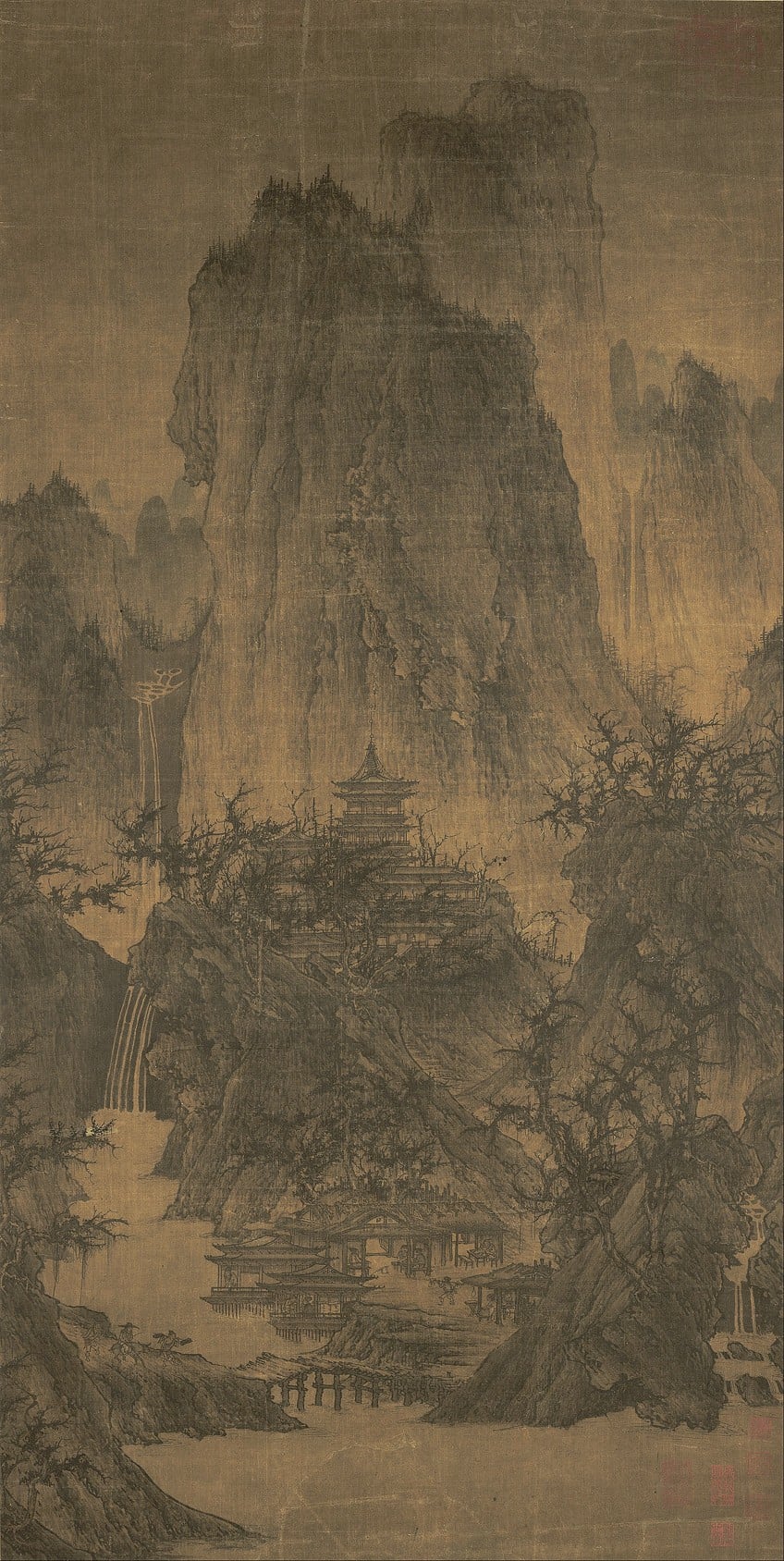
According to reports, Li Cheng treasured the medium of ink like gold and was extremely talented at portraying intangible textures like air and clouds. Li Cheng was recognized for his winter landscape paintings with simple compositions. A Solitary Temple Amid Clearing Peaks is a Chinese painting on silk that illustrates the monumental misty mountains and temple of the Chinese landscape.
Li Cheng’s remarkable brushwork is one to be admired for his sense of control over the ink and the delicacy with which he treats the medium when rendering the finer details.
Li Bai Strolling (Song Dynasty) by Liang Kai
| Artist | Liang Kai (c. 1140 – 1210) |
| Period | Song Dynasty (960 – 1279) |
| Medium | Handscroll; ink on paper |
| Dimensions (cm) | 81.1 x 30.5 |
| Where It Is Housed | Tokyo National Museum, Tokyo, Japan |
Perhaps one of the most famous Chinese portraits by Liang Kai, Li Bai Strolling is a simple yet genius display of Kai’s mastery over ink. The portrait is said to have once formed part of a pair of drawings and was probably owned by a nobleman by the name of Matsudaira Fumai.
Liang Kai’s artwork was most famous for reflecting his interest in Chan Buddhism and was an established court painter at the imperial painting academy during the Southern Song Dynasty.
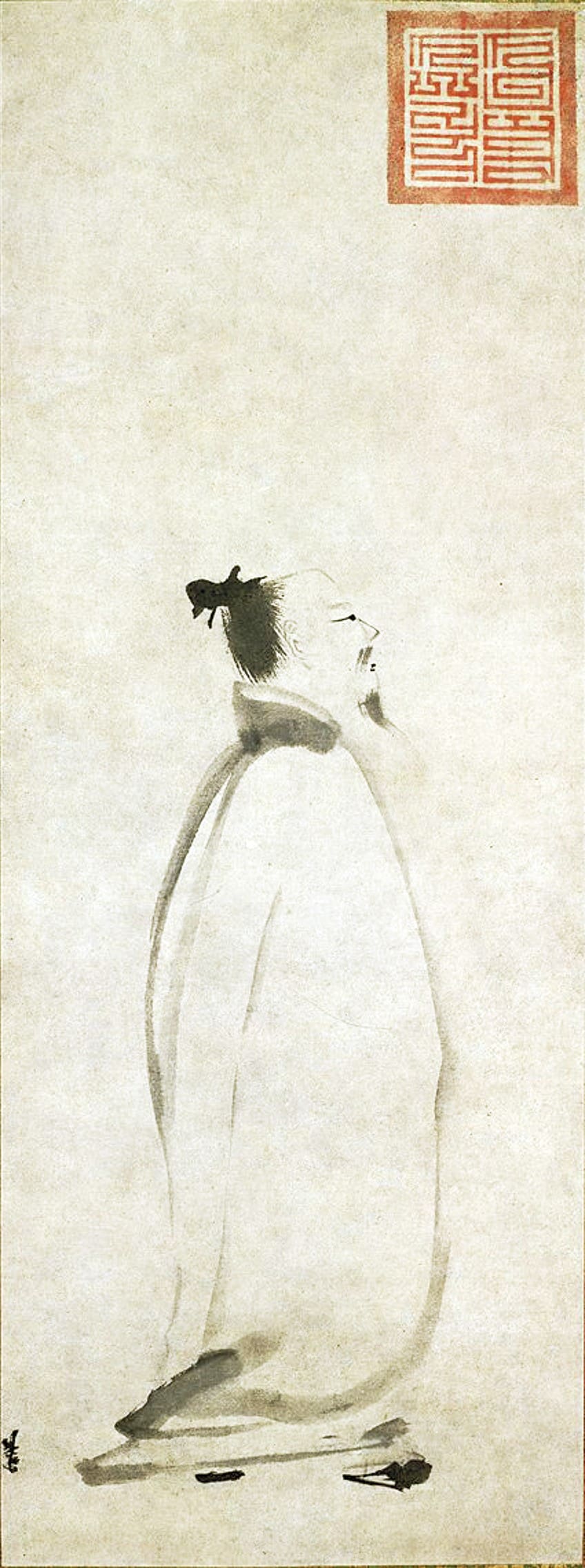 Li Bai Strolling (Song Dynasty) by Liang Kai; Liang Kai, Public domain, via Wikimedia Commons
Li Bai Strolling (Song Dynasty) by Liang Kai; Liang Kai, Public domain, via Wikimedia Commons
After refusing a promotion to the Golden Belt, he turned to alcohol and earned himself the nickname “madman Liang”. It is unknown why he turned down the honored position but one might assume he preferred to live out the rest of his days pursuing his interests.
Most of his works were popular in Japan due to his style not being favored by the art collectors of the Southern Song Dynasty.
A Thousand Li of Rivers and Mountains (1113) by Wang Ximeng
| Artist | Wang Ximeng (1096 – 1119) |
| Date | 1113 |
| Period | Song Dynasty (960 – 1279) |
| Medium | Handscroll, ink, and colors on silk |
| Dimensions (cm) | 51.5 x 1191.5 |
| Where It Is Housed | Palace Museum, Beijing, China |
This exquisite blue-green Chinese painting on silk by Wang Ximeng was made in 1113 when Ximeng was only 18 years old. It is the only surviving painting made by Wang Ximeng who sadly passed away two years after this painting was created.
The painting illustrates the vast landscape of the country and symbolizes an ideal world filled with harmony as per the Daoist fairyland described by Emperor Huizong.
 The beginning of A Thousand Li of Rivers and Mountains (1113) by Wang Ximeng; Wang Ximeng (王希孟), Public domain, via Wikimedia Commons
The beginning of A Thousand Li of Rivers and Mountains (1113) by Wang Ximeng; Wang Ximeng (王希孟), Public domain, via Wikimedia Commons
Painted using scarce mineral pigments, the landscape takes the format of a hand scroll with scattered perspectives, including three visual angles of height, a level-distance, and depth. These complex landscapes in early Chinese painting were a common trait of the East and are one to be admired for their thought and attention to the landscape.
Upon inspection of the landscape, the viewer is guided by the outlines of the mountains and the wavy edges of the river that reaches far out into the distance.
The opulent blue-green mountains in the foreground stand out and help create a sense of depth to the landscape while fulfilling their visual function of creating distance. Wang Ximeng captures the true essence of the landscape in all its beauty and vastness.
Nymph of the Luo River (c. 1150 – 1250) by Gu Kaizhi
| Artist | Gu Kaizhi (Changkang) (345 – 406) |
| Date | c. 1150 – 1250 |
| Period | Southern Song Dynasty (1127 – 1279) |
| Medium | Handscroll, colors, and ink on silk |
| Dimensions (cm) | 24 x 310 |
| Where It Is Housed | Smithsonian National Museum of Asian Art, Washington, D.C., USA |
Despite the original artwork of Nymph of the Luo River being lost to time, many artists of the Southern Song Dynasty made copies as seen in the painting by Gu Kaizhi above. Gu Kaizhi, also known as Changkang, was a famous politician, poet, calligrapher, and artist of ancient China who also produced three books on painting theory. A highly-skilled man of many talents, Gu Kaizhi also served under the warlord Huan Xuan who was a big fan of Changkang’s art and even dedicated a special boat to transport his works to safety in the event of a war.
Nymph of the Luo River is a painting that brings to life the poem of prince Cao Zhi published in 222 CE.
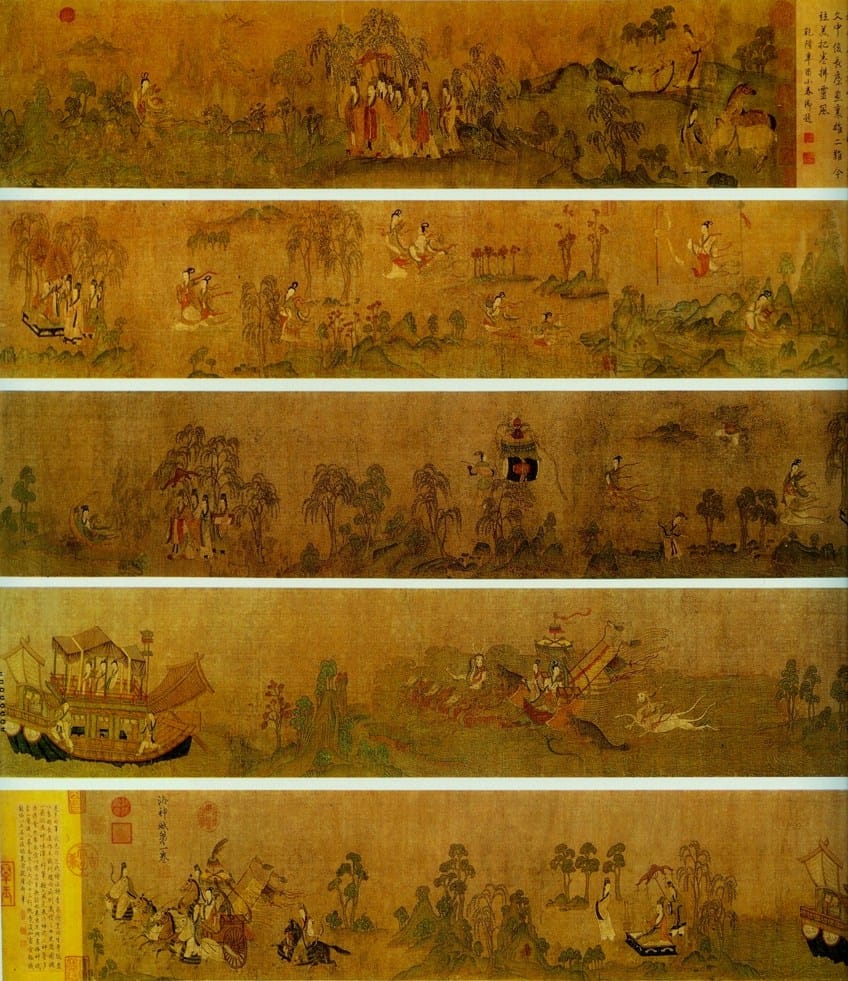
The poem narrates the story of an imagined romantic tale of the prince who meets a nymph (Fu Fei) at the Luo River located in Central China. According to the poem, the two fall in love but have to part ways with one another. The duo is painted multiple times throughout the painting in different scenes but identified by their hairstyles and headdresses.
The painting was executed in light colors with the landscape imagery outlined in a darker pigment and then color-washed in.
Gu Kaizhi accentuated the light and flowy nature of their garments, which sway in the direction of the wind and evoke a light-weighted feeling. This aligns with the feelings of love and longing that the prince experiences when writing the poem.
Ten Kings of Hell (c. 1195) by Jin Chushi
| Artist | Jin Chushi (active in the late 12th century) |
| Date | Before 1195 |
| Medium | Hanging scroll; ink and color on silk |
| Dimensions (cm) | 203.2 x 69.9 |
| Where It Is Housed | The Metropolitan Museum of Art, New York City, New York, USA |
The Ten Kings of Hell hanging scroll painting is one of the most famous Chinese paintings that portray the bureaucratic process of judgment after death overseen by each king. This scroll represents one king out of a set of 10 other scrolls with other kings.
The scene is based on the Chinese adaptation of the Indian Buddhist narrative regarding judgment where individuals require the permission of the kings to transmigrate into their next lives.
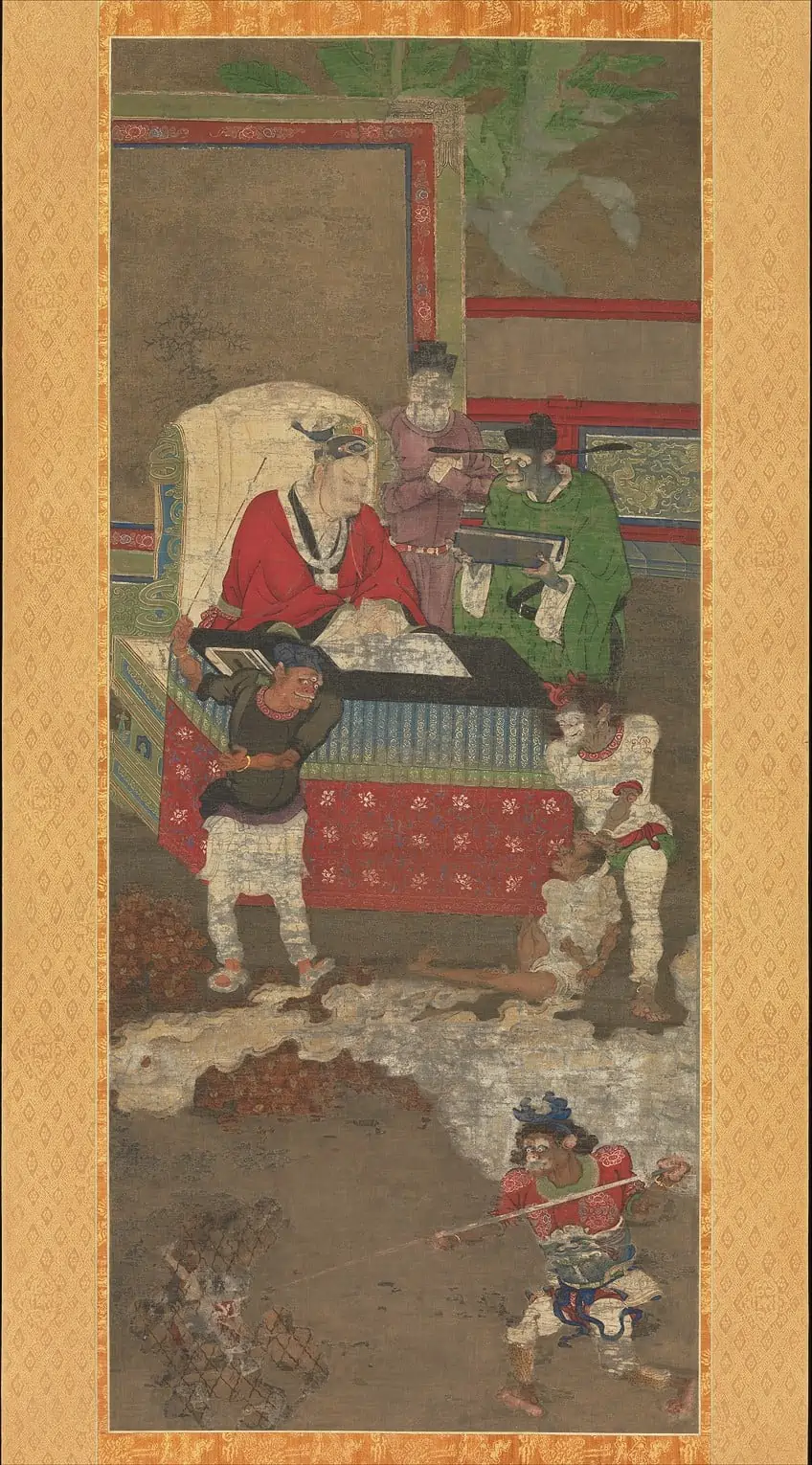
Each soul faces judgment by a different king for several weeks. The foreground of the painting illustrates the demons inflicting punishments on the wicked souls. Inscriptions discovered on the paintings suggest that they were created by a Buddhist layman called Jin Chushi in Ningbo (Qingyuanfu) and date to before the year 1195.
This is one of the most well-known ancient Chinese paintings that depict a Buddhist narrative from the Song Dynasty.
Plum Blossoms in Early Spring (Yuan Dynasty) by Wang Mian
| Artist | Wang Mian (c. 1287 – 1359) |
| Period | Yuan Dynasty (1271 – 1368) |
| Medium | Hanging scroll and ink on silk |
| Dimensions (cm) | 151.4 x 52.2 |
| Where It Is Housed | National Palace Museum, Taipei, Taiwan |
Plums Blossom in Early Spring is an undated Chinese painting that was created during the Yuan Dynasty era by Wang Mian. This famous Chinese painting on silk depicts a plum tree in full blossom with the flowers standing out in a bright white pigment against the empty sky and the dark bark of the tree and its branches.
Wang Mian’s style name was Yuanzhang and was defined by his many plum tree paintings, which highlighted his boldness in the painting. This is just one of the few surviving plum blossom paintings attributed to Wang Mian.
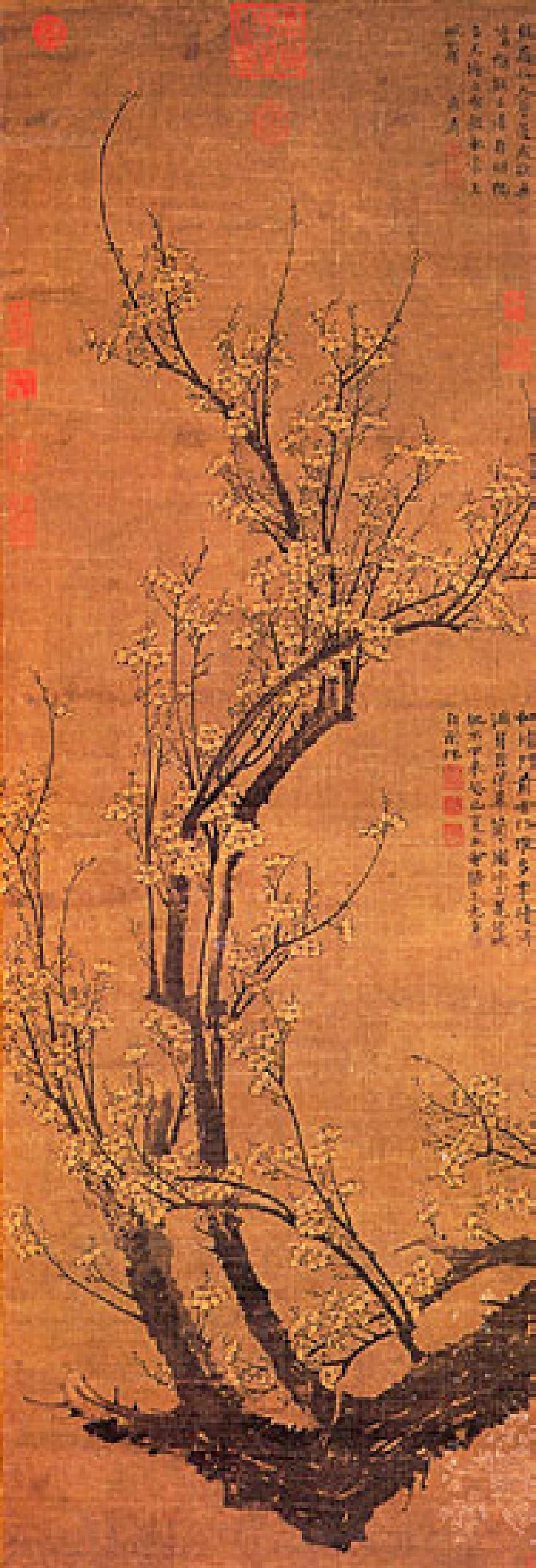
Landscape album (1699) by Bada Shanren
| Artist | Bada Shanren (Zhu Da) (1626 – 1705) |
| Date | 1699 |
| Period | Qing Dynasty (1644 – 1911) |
| Medium | Album of twelve leaves; ink and color on paper |
| Dimensions (cm) | 18.7 x 23.2 |
| Where It Is Housed | The Metropolitan Museum of Art, New York City, New York, USA |
This collection of Chinese drawings illustrates the many landscape scenes as seen through the eyes of one of the greatest Qing Dynasty painters of the 17th century. Bada Shanren was an influential figure in Chinese painting who had a reputation for being a “crazy Buddhist monk” who faked being deaf to escape death after the fall of the Ming Dynasty in 1644.
His drawing style was established as Expressionist and calligraphic and can be seen throughout this landscape album.

The landscape album consists of 12 ink-wash drawings that showcase his dry brushwork and a curated selection of motifs such as an empty pavilion, cone-shaped rock formations, bare trees, and diagonally-receding mountains. His playful style can also be seen in his insertion of human figures and the slight addition of color.
Portrait of Houqua (c. 1840) by Tingqua
| Artist | Guan Lianchang (Tingqua) (1809 – 1870) |
| Date | c. 1840 |
| Medium | Watercolor on ivory |
| Dimensions (cm) | 17.1 x 11.4 |
| Where It Is Housed | The Metropolitan Museum of Art, New York City, New York, USA |
Tingqua is one of the most famous Chinese artists and miniaturists of the 19th century who specialized in paper works and unlike previous Chinese artists in traditional Chinese painting, Tingqua utilized oil paints. Tingqua is also identified by his birth name Guan Lianchang and ran his studio from the 1820s until the 1860s.
Around 1840, Tingqua produced one of the most famous Chinese portraits, Portrait of Houqua, which showcased the portrait of a man believed to be Houqua Wu Bingjian.
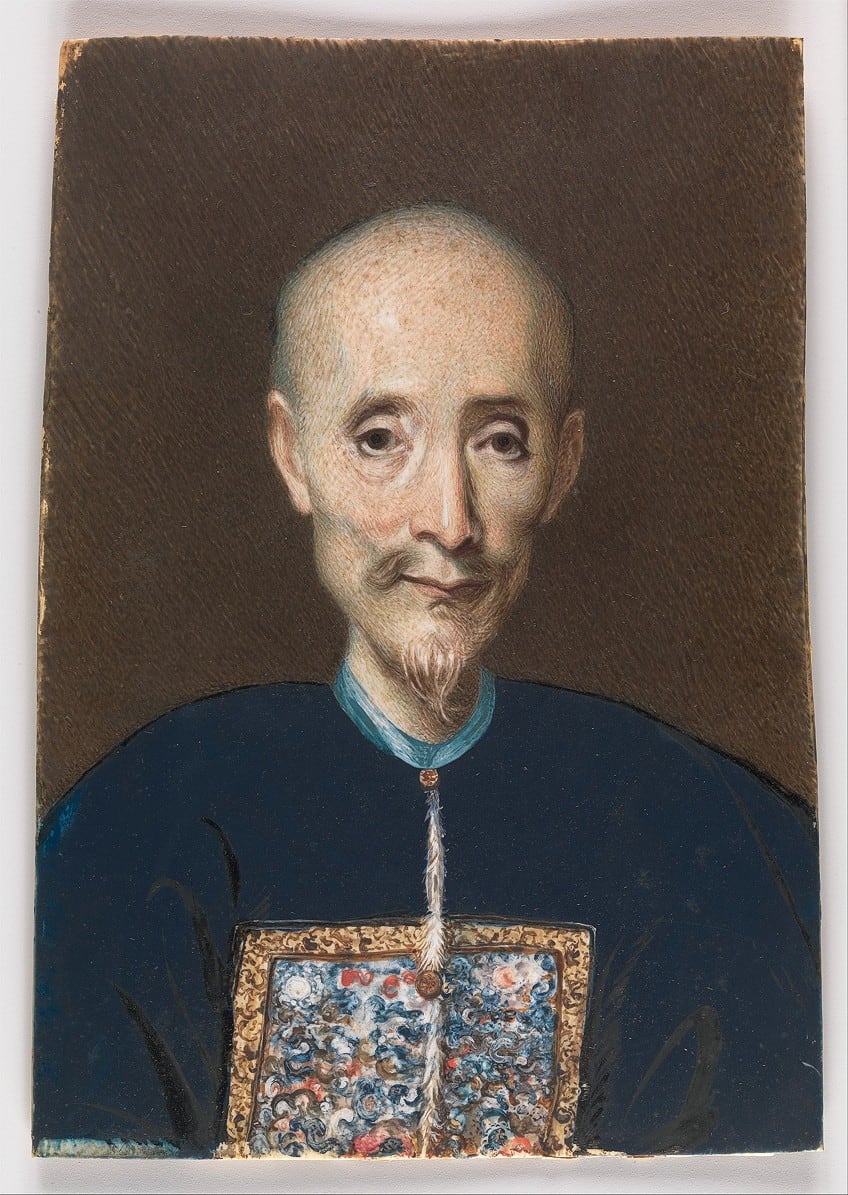
Wu Bingjian was at one point the wealthiest man on earth in the Jiaqing and Daoguang periods. The subject may also be his son, Wu Shaorong. Houqua was a senior hong merchant from Canton and one of the few individuals with a permit to trade silk and porcelain with foreigners.
Hong refers to a Chinese merchant intermediary in the Canton trade system.
Houqua’s wealth was calculated to be around $26 million in 1834, which would have made him one of the wealthiest living individuals in society. His character was recorded as a generous and honest man across all his dealings, both personal and professional. He also made investments in American railroads and other advancing technologies of the time.
Eagle on A Pine Tree (1940) by Qi Baishi
| Artist | Qi Baishi (1864 – 1957) |
| Date | 1940 |
| Medium | Hanging scroll; ink on paper |
| Dimensions (cm) | 173 x 54.6 |
| Where It Is Housed | The Metropolitan Museum of Art, New York City, New York, USA |
Qi Baishi was one of the most famous Chinese artists of the 20th century who created some of the most elegant Chinese paintings. He was most famous for his whimsical style and playful works. Qi Baishi was also a self-taught artist who traveled across China and was greatly influenced by the Qing Dynasty artist Bada Shanren and Xu Wei from the Ming Dynasty.
His paintings were just as free as his brushwork and covered a multitude of themes, including animals, vegetation, figures, and toys. Around 1953, Qi Baishi was elected the president of the China Artists Association.
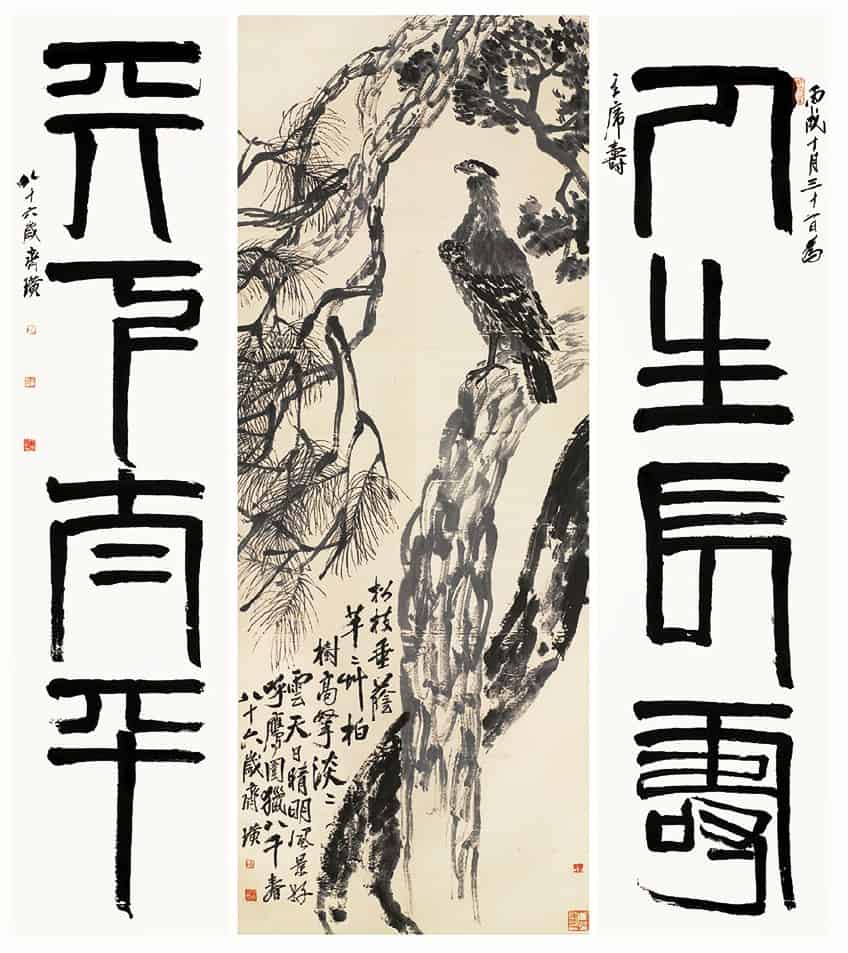
Eagle on a Pine Tree is one of Qi Baishi’s most famous paintings depicting the great eagle rendered with expert use of positive and negative space, and bold, sharp brushwork. Qi’s varied pressure with the brush and balance of the ink allows for a striking impression of the scene.
Eagle on a Pine Tree also carried a political connotation and was affiliated with Qi’s response to an internal conflict among Chinese nationals and the threat of foreign attacks around the 1930s.
Lotus (c. 1980) by Zhang Daqian
| Artist | Zhang Daqian (or Chang Dai-Chien) (1899 – 1983) |
| Date | c. 1980 |
| Medium | Hanging scroll; ink and color on paper |
| Dimensions (cm) | 84 x 50.8 |
| Where It Is Housed | The Metropolitan Museum of Art, New York City, New York, USA |
Lotus is a painting by Zhang Daqian executed around the 1980s in the traditional hanging scroll format. Zhang Daqian or famously known as Chang Dai-Chien was one of the most celebrated Chinese artists of the 20th century who established himself as a Modernist and Expressionist painter.
Daqian was also well-known for his exceptional talent in forging works of the old masters and was considered “so prodigious in Chinese ink and color that he could paint anything”.
Zhang Daqian paid close attention to the materials he used and studied all materials with a desire to know them and would sometimes include comprehensive documentation of the type of paper and the origin of ink he used. His first commission was allegedly from a traveling fortune-teller who tasked the 12-year-old Daqian with creating a new set of divination cards.
Around the 1950s, Daqian’s eyesight began to worsen and this was reflected in his painting style, which tended toward Abstraction and bolder shapes.
Lotus reflects his later move toward Abstraction as seen through the heavy hand on the brushwork that was still balanced out by the thinner outlines of the lotus flower and large leaves. Daqian was also strategic in his placement of the red ink, which adds just the right amount of color to enliven the flower.
Water Village in Jiangnan (1987) by Wu Guanzhong
| Artist | Wu Guanzhong (1919 – 2010) |
| Date | 1987 |
| Medium | Ink and color on paper |
| Dimensions (cm) | 43 x 47 |
| Where It Is Housed | Private collection |
Wu Guanzhong was one of the most famous Chinese artists of the 20th and 21st centuries who was credited with being one of the major founders of Modern Chinese painting. Wu Guanzhong’s work is a culmination of both artistic influence from the West and East, combining the styles of Fauvism with the Chinese art form of calligraphy. Water Village in Jiangnan depicts a modern and simple rendition of a bride in a village over a lake.
The painting was exhibited across several major museums in China and is admired for its variety of wide brushwork and shading to outline the basic architecture of the landscape while defining the texture of each object.
Guanzhong uses a lighter ink wash to depict the water and indicate that the scene takes place in the daytime. He also skillfully adds another layer of ink wash under the bridge to cast a shadow. Guanzhong’s excellent balance of negative space allows the viewer to mentally fill in the details of the structure of the bridge.
A crowd of people is also depicted using points or small dots of color in red, green, yellow, and black, which adds life to the landscape.
This straightforward painting garnered the attention of many art critics across the East and West and was lauded for its fresh perspective on Chinese culture. Other works by Guanzhong include paintings with subjects such as plants, birds, and various other Contemporary scenes.
Book from the Sky (1987 – 1991) by Xu Bing
| Artist | Xu Bing (1955 – Present) |
| Date | 1987 – 1991 |
| Medium | Installation of hand-printed books and ceiling and wall scrolls printed from wood letterpress type; ink on paper |
| Dimensions (cm) | Each book, open: 46 x 51; three ceiling scrolls, each: 96.5 x 3500; wall scroll, each: 280 x 100 |
| Where It Is Housed | The Metropolitan Museum of Art, New York City, New York, USA |
Xu Bing is one of the most famous Chinese artists who created this four-piece book installation with imaginary Chinese characters. Xu Bing is a globally-renowned artist who is celebrated for his skills in printmaking, installation, and most importantly text-based artworks that communicate the importance of language and words and their influence on the world.
Xu Bing invented his own characters, which are said to hold special power in and of themselves.
These characters are unable to be decoded and incite questions about Chinese identity and what that means in relation to the written text. Bing’s beliefs about writing revolve around the “essence of culture” and his subsequent subversion of characters highlight our desire and need to communicate as well as the dangers that come with the distortion of original meanings.
These Chinese drawings contain over 4,000 imaginary characters and were first exhibited in 1988 in Beijing.
In the standard Mandarin language, his characters are considered completely meaningless. His artwork caused controversy in 1989 when the Tiananmen Square protests sparked the attention of the government and the subsequent investigation into Xu Bing’s work by the government. Xu Bing left China in 1991 and relocated to the United States to further investigate his study into the deconstruction of language and invocation of discomfort.
The most famous Chinese artists have all shared one thing in common: attention to materiality and a remarkable talent for the manipulation of ink and the brush. These famous Asian paintings are reminders of the six principles of traditional Chinese painting and offer imaginative ways of making and viewing a painting through the lens of the East. We hope that these famous Chinese artworks have inspired you to pick up a brush and try your hand at ink painting.
Take a look at our Chinese paintings webstory here!
Frequently Asked Questions
Who Are the Artists Behind Some of the Most Famous Asian Paintings?
The artists behind some of the most famous Asian paintings include artists like Gu Kaizhi, Qi Baishi, Zhang Daqian, Dong Qichang, Fan Kuan, Shen Zhou, BCEa Shanren, Li Cheng, Han Gan, and many more ancient Chinese painters.
What Are the Characteristics of Traditional Chinese Painting?
The characteristics of traditional Chinese painting include subjects such as landscapes, symbolic imagery through auspicious animals, and themes related to ancient Chinese cultural beliefs and folklore. Other characteristics of traditional Chinese painting include vertical formats and the use of materials such as handscrolls, silk, paper, ink, and color pigments. Traditional Chinese paintings are a demonstration of brushwork often connected to calligraphy and can sometimes incorporate painting techniques from the West.
What Is the Most Expensive Chinese Painting?
Among the most expensive Chinese paintings is Nu (1965) by Chinese artist Sanyu, which was initially sold in 2004 for $24 million but sold again at auction in 2021 for $145 million. Closely following Sanyu’s valuable painting is Twelve Landscape Screens (1925) by Qi Baishi, which sold for $140.8 million.
Jordan Anthony is a Cape Town-based film photographer, curator, and arts writer. She holds a Bachelor of Art in Fine Arts from the University of the Witwatersrand, Johannesburg, where she explored themes like healing, identity, dreams, and intuitive creation in her Contemporary art practice. Jordan has collaborated with various local art institutions, including the KZNSA Gallery in Durban, the Turbine Art Fair, and the Wits Art Museum. Her photography focuses on abstract color manipulations, portraiture, candid shots, and urban landscapes. She’s intrigued by philosophy, memory, and esotericism, drawing inspiration from Surrealism, Fluxus, and ancient civilizations, as well as childhood influences and found objects. Jordan is working for artfilemagazine since 2022 and writes blog posts about art history and photography.
Learn more about Jordan Anthony and about us.
Cite this Article
Jordan, Anthony, “Famous Chinese Paintings – Discover Ancient Chinese Paintings.” artfilemagazine – Your Online Art Source. November 29, 2022. URL: https://artfilemagazine.com/famous-chinese-paintings/
Anthony, J. (2022, 29 November). Famous Chinese Paintings – Discover Ancient Chinese Paintings. artfilemagazine – Your Online Art Source. https://artfilemagazine.com/famous-chinese-paintings/
Anthony, Jordan. “Famous Chinese Paintings – Discover Ancient Chinese Paintings.” artfilemagazine – Your Online Art Source, November 29, 2022. https://artfilemagazine.com/famous-chinese-paintings/.



